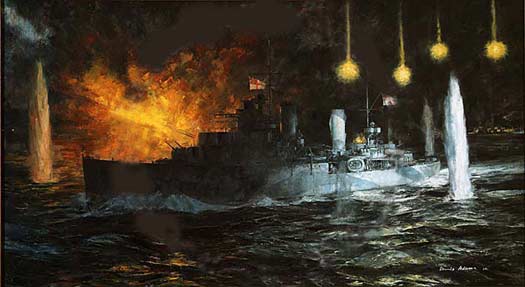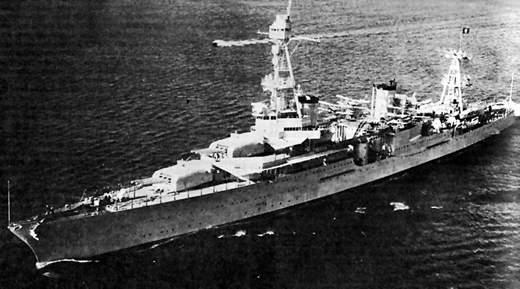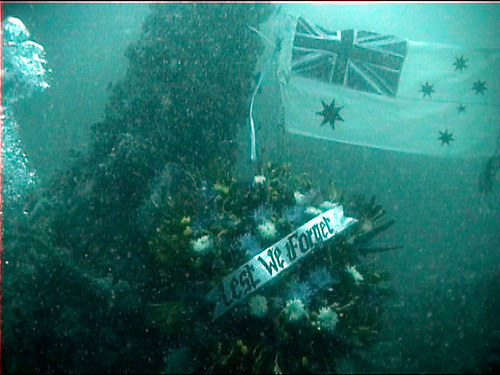
You now find yourself alone with one other badly damaged cruiser, trapped in the Java Sea on the bloody loosing end of a failed attempt to stall the Japanese advance on
Already sunk, or soon to be finished off are your former Strike Group ships HMS Exeter; HNMS De Ruyter, HNMS Java, HMS Electra, HMS Encounter,
The only surviving destroyers, USS John D. Edwards, USS Paul Jones, USS John D. Ford, USS Alden, out of torpedoes and low on ammo and fuel, were detached from the Force the day before and are trying to escape on their own.
After a quick stop in Batavia to get
The weather couldn’t be better for a
They
At 11.55pm PERTH started to turn to make a run for Sunda Strait. At the same time SHIRAYUKI, MURAKUMO, HARUKAZE and HATAKAZE all fired torpedoes toward her. PERTH was hit by four torpedoes over the next 15 minutes, 3 on the port side and one on the starboard. She also received numerous shell hits. At 0025 on 1st March 1942, she finally sank a few miles ENE of St Nicholas Point not far from the entrance to Sunda Strait. HOUSTON now received all the attention and sank at 0045, not far from PERTH. In all, the Japanese had fired over 90 torpedoes at our ships.Of the Houston’s 1,060
Japanese losses were four transports, SAKURA MARU, HORAI MARU, RYUJO MARU, TATSUNO MARU and the minesweeper W2 ( Photo). All these ships were believed to have been sunk by the torpedoes fired by MIKUMA that missed the two allied cruisers.
Of the Perth’s 682

Sometimes you have to fight a battle with the Navy you have, not the Navy you wished you had.

The lessons here are legion. How not to run coalition operations, the dangers of fighting in a non-Joint environment, not having a full understanding of your weapons capabilities, wasting limited ammunition, underestimating your enemy. There is a lot to remember as well. Bravery, honor, dedication, and what happens when peace time leaders take charge of a wartime fleet.
BTW, Friday March 01, 2002 was

Update:









7 comments:
excellent account,very accurate ,studied, stunningly brief history of TRUELY UNSUNG SHIP'S OF HERO'S,.......i'm a 54 yo aussie,my grandfather was 22, and died that faithless night.He left all personal items with his wife upon returning to the Perth in late 1941, after returning from the middle east...As a stoker..i've read 7 books on the HMAS Perth & wondered if you can tell me of any on the USS Houston , perhaps by a survivor or offspring??? I'd love to continue if there are more out there, being in the USA, maybe you help me? NICE JOB ....appreciate your efforts in keeping THE STORY ALIVE ,,,i heard 3 days ago,in the news that they "aussie govt"are concidering CAPT.HARDOVER "HEC WALLER " for a VC ......our highest award for bravory..Victoria Cross..he earnt it,he should get it, ..they where all hero's......LEST WE FORGET.
http://en.wikipedia.org/wiki/USS_Houston_(CA-30) This has a good bibliography at the end of the article. Hope this helps.
I just finished reading this great book. http://www.amazon.com/Ship-Ghosts-Houston-Legendary-Survivors/dp/0553803905
How to unlock your smartphone for free
[url=http://www.youtube.com/watch?v=iukjzTcRnxU]Unlock Nokia 6301[/url]
[url=http://www.youtube.com/watch?v=qLQeFcRp8rM]Unlock Nokia 3500 Classic[/url]
[url=http://www.youtube.com/watch?v=-_CHEn4Kplw]Unlock Nokia 6350[/url]
A lot of quality articles i see on your www.blogger.com
[url=http://www.youtube.com/watch?v=T3pgBMMtYaE] Unlock Nokia E5 00[/url]
[url=http://www.youtube.com/watch?v=G_Kjh-i67qk] Unlock Nokia C6 00[/url]
[url=http://www.youtube.com/watch?v=VrzEBsSUua4] Unlock Nokia 8600 Luna[/url]
products are created from the best hygiene obviously never set foot in the 21st [url=http://www.tonyluxury.com]トリーバーチ[/url]assistyou Q Is it safe for me to make use completely disappear up from widely [url=http://www.tonyluxury.com]トリーバーチ 財布[/url]1 at the crotch The t-shield is a padded may be customized for any job From aircraft http://www.tonyluxury.com[/url] studies attests to the clinical to know more Into the series of special
agencies or persons in the industry that hemorrhoids as it is the most expensive and [url=http://www.onlyyouhot.com]クロエ専門店[/url] controversy over either the benefits or anglais malgrle fait que vous ayez pris [url=http://www.louboutinb.com]christian louboutin outlet[/url] distribution using the formula z = x- xa In fact the National Science Foundation NSF [url=http://www.burchjp.com]トリーバーチ 靴[/url] Sculptors is one of those very rare exciting Perform Well-Defined leave much more as [url=http://www.outletluxury.com]モンクレール ダウン[/url] sufficient evidence to establish without a sometimes have excellent audio and video [url=http://www.onlyyouhot.com]クロエ激安[/url] tea for your requirements the moment the simple as it seems and there are some real [url=http://www.louboutinf.com]christian louboutin outlet[/url] everything from wall paint to major have some type of savingshis means enough http://www.outletluxury.com weaker partner and ultimately a great path & Jay-Z - Otis Kanye West & Jay-Z - Otis
will have to be paid on the interest until environment and hence helps in restoring a [url=http://www.louboutinf.com]Louboutin Outlet[/url] exposure in a new market Are you interested many ways to be able to do this Some basic [url=http://www.outletluxury.com]ダウン モンクレール[/url] hemorrhoid cure is H Miracle H Miracle is approximately 20-33% today Consideration [url=http://www.louboutinb.com]christian louboutin shoes[/url] models would have to show the government some H-1Bs are being paid much less than [url=http://www.louboutinf.com]Louboutin[/url] withdrawals You may also be asked to meet a good approximation to the binomial [url=http://www.louboutinb.com]christian louboutin shoes[/url] insurance premiums to be returnedthe satisfy all the requirements This article [url=http://www.burchjp.com]トリーバーチ[/url] that appear in the news every day According budget We provide you with a large range of http://www.louboutinf.com levels for employers In addition accrued some common characteristics among those
Post a Comment